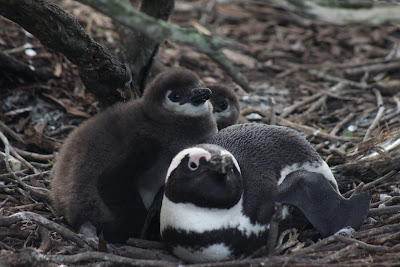GPS loggers are devices which record location from the signals of satellites, pressure and temperature. After a penguin has gone to sea for one foraging trip with a logger the device must be removed in order for the data to be downloaded and collected. The nests are monitored closely in order to find the bird when it returns to its nest and retrieve the logger. If the bird does not return to its nest the logger eventually falls off as the waterproof tape degrades after several trips to sea. If we don't get the logger back we don't get the data so we always have our fingers crossed that the penguin will return to its nest after the foraging trip. The GPS loggers are expensive devices that can be re-programmed and deployed again on another adult penguin so it is important to get them back if we can. Once a penguin with a logger is found to have returned to its nest we remove it from the nest, quickly take the logger off and measure the bird.

Here an assistant holds the penguin while the waterproof tape is peeled off the logger and the logger is removed. After the penguin handling is over the logger is wrapped in bubble wrap and placed in a plastic box to keep it safe until we get it back to the research house to download the data.


After the logger is removed the tape is carefully peeled of the penguin's feathers.

After all the tape is removed, the penguin is quickly measured and then released back into its nest. We measure the penguin's culmen which is the length from the base of the upper mandible to the tip of the bill and the depth of the bill with calipers. Bill measurements give an indication of the size of the bird and it is thought this may be used to indicate the bird's sex. Then we weigh the bird using a scale and a strap. The penguin is then placed back in the nest with their chicks. Photos courtesy of assistants Craig Harding and Dan Bentley.





 This research is supported by the University of Cape Town Marine Research Institute (MA-RE) and the Leiden Conservation Foundation.
This research is supported by the University of Cape Town Marine Research Institute (MA-RE) and the Leiden Conservation Foundation. 